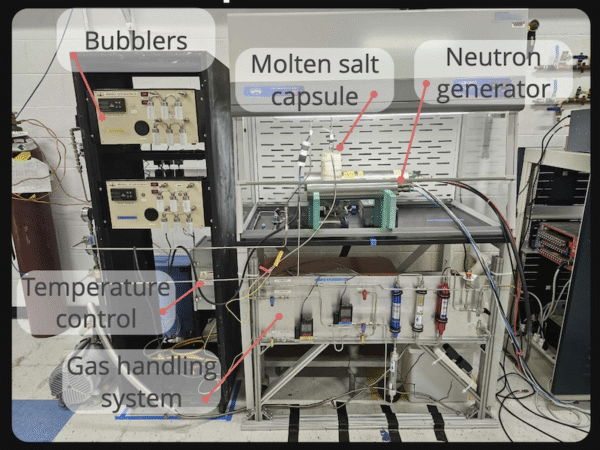Fusion’s energy comes from two light elements fusing into a heavier one, a reaction that generates intense light, heat, and energetic neutrons. If fusion’s energy can be harnessed, it could serve as a paradigm-shifting source of clean energy, an outcome that is being aggressively pursued by public and private sectors hoping to roll out commercial fusion plants in the 2030s.
Currently, a type of donut-shaped fusion device called a tokamak is one of the main concepts being considered for practical fusion power, and research has suggested that fuel comprised of two types of hydrogen—deuterium and tritium— offers the best balance of efficiency and energy output. Deuterium can be filtered out of seawater, but tritium is exceptionally scarce, and a single fusion power plant using deuterium-tritium (D-T) fuel would use up all the earth’s tritium reserves in a year. If commercial D-T fusion is to become reality, a reliable supply of tritium must be established as well.
For decades, fusion scientists have proposed solving the tritium scarcity issue by using lithium salt to capture the neutrons ejected in a D-T fusion reaction. When neutrons react with lithium, tritium is produced. Surrounding a fusion device’s plasma vessel with a lithium-filled “blanket” creates an environment in which tritium forms during a fusion reaction. The tritium can then be extracted from the blanket and reprocessed for use as fuel. Simulations have shown that in a D-T fusion power plant, the right lithium salt mix in a large enough blanket can provide that plant with adequate tritium to fuel itself, a state called tritium self-sufficiency.
However, only a handful of studies have attempted to validate the blanket concept in a lab setting, and while rates of tritium production in lithium and lithium mixes have been measured, establishing the efficiency of production has been significantly more difficult to quantify.
That changed when a team led by Plasma Science and Fusion Center principal research scientist Kevin Woller became the first in the world to experimentally measure the full tritium breeding ratio (TBR) of a breeding experiment. The TBR is the ratio of tritium atoms produced to tritium atoms consumed by a fusion reaction, and it is a crucial yardstick for determining whether a fusion power plant can be tritium self-sufficient and therefore commercially viable.
“One way to think of it is, if fusion is a wood stove, then you could have the best chimney, the best glass, but if you don’t have logs to burn, the rest of it is useless,” said Rémi Delaporte-Mathurin, a research scientist in Woller’s group. “Our goal is to advance the readiness of fuel cycle technologies for fusion power plants. Here, we start with the breeding blanket. It’s our version of developing sustainable forestry.”
In a recent paper called “Advancing tritium self-sufficiency in fusion power plants: insights from the BABY experiment”, the authors describe their research and findings from the Build A Better Yield (BABY) experiment. In it, a crucible filled with 100 milliliters of a lithium salt mix was kept at 700C° and exposed to two D-T neutron sources replicating reproducing the high-energy neutrons produced in a D-T fusion reaction. Tritium was produced in the salt during neutron exposure. The team passed helium gas over the salt’s surface to carry the tritium into a specially designed collection system, which allowed them to measure the total tritium output. By quantifying the number of neutrons emitted by the sources and the number of tritium atoms collected, the researchers calculated the experiment’s TBR to be approximately 0.000357.

There are key differences between BABY and other tritium breeding experiments in the literature that make BABY’s findings particularly notable: First, although the experiment demonstrated a TBR that is about four orders of magnitude lower than what is required for a commercial fusion power plant to achieve tritium self-sufficiency, this is still the first instance of a total TBR measurement, an essential metric for validating the tritium production models that the fusion community has been using to inform their work. Second, in a departure from other efforts using lower energy neutron sources, BABY utilized 14MeV high-energy neutron sources that replicate the energy of those produced in a D-T reaction, allowing for results that more closely emulated what might be seen in a fusion power plant blanket. Third, the tritium produced by BABY and collected with helium was almost entirely in an insoluble form rather than the expected soluble form— a reminder of tritium’s complex behavior and the importance of validating models with direct experimentation.
According to Delaporte-Mathurin, “These results mark a small but vital step on the path to fuel self-sufficiency in fusion power plants. It’s a powerful reminder of how far we’ve come, and the exciting journey ahead of us.”
The results from BABY, along with the new questions raised by those results, have paved the way for the next version of the experiment that is currently ongoing: a larger 1-liter setup using a different lithium salt mix and a more refined design that can address the discrepancies uncovered by BABY. These efforts are important proof-of-concepts to prepare for LIBRA (Liquid Immersion Blanket: Robust Accountancy), an experiment that will feature a 500-liter tank of FLiBe, a molten fluoride salt containing lithium and beryllium that is being considered for deployment in the blankets of proposed commercial fusion devices. When coupled with higher source-rate 14 MeV neutron sources, LIBRA will offer one of the most representative experimental platforms to date for studying fusion power plant blanket conditions.


